Paraphenylenediamine (PPD)
What are the aims of this patient information leaflet?
This leaflet has been written to help you understand more about your contact allergy. It tells you what a contact allergy is, what causes this allergy and what you can do about it.
What is contact allergy?
Dermatitis, also known as eczema, describes a type of inflammation of the skin. Contact dermatitis or contact eczema is a term used when this inflammation is caused by direct or indirect skin contact with something in your environment. Allergic contact dermatitis occurs when your immune system causes allergy to a very specific chemical or substance that has been in contact with the skin.
What causes your specific allergy?
Your patch tests indicate that you have a contact allergy to paraphenylenediamine (PPD).
What is paraphenylenediamine (PPD)?
PPD is a permanent hair dye which is found in dyes used in hairdressing salons and in home colouring products. It is also used to tint eyelashes and eyebrows.
What are some products that contain paraphenylenediamine (PPD)?
- Some semi-permanent hair dyes
- Temporary black henna tattoos
- Fur, leather and clothing dyes
- Rubber and plastics manufacturing, epoxy resin hardeners
- Photographic developing fluids
- Photocopying dyes and printing inks.
Some related dyes may also cause problems and should usually be avoided too.
- toluene-2,5-diamine sulfate (4-toluenediamine, PTD)
- 2-nitro-p-phenylenediamine (2-nitro-4-phenylenediamine)
- m-aminophenol and p-aminophenol
- p-methylaminophenol sulfate
- methoxymethylparaphenylenediamine.
It may be found in dark and light colour dyes such as those used for highlights although it is found in a higher concentration in dark dyes. The patch test done by hairdressers prior to a treatment may help to detect a problem but is not reliable.
Semi-permanent or temporary hair dyes that claim to be PPD-free or related dyes including henna dyes may not be OK. Dyes that are usually fine to use include pure henna, henna and indigo dyes, bismuth citrate dyes.
Remember, always check the label, these lists can never be complete and ingredients change.
How can I manage my allergy?
This means that you should avoid putting products containing paraphenylenediamine (PPD) onto your skin in the future.
If you are a hairdresser it is possible to protect your hands by using nitrile or plastic gloves but avoid latex rubber gloves as dye can penetrate these gloves. Change your gloves often. Avoid cutting newly dyed hair without gloves but previously dyed hair should not be a problem. Consider cutting hair before dying.
Self-care (what can I do?)
Always check the ingredient listing on the product, package or package insert as these lists can never be complete and ingredients change. This is particularly important for any products purchased outside the EU where some allergens may not be banned.
Created: 2016

